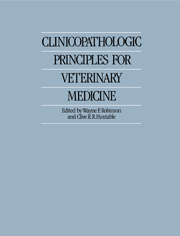Book contents
- Frontmatter
- Contents
- Contributors
- Preface
- Acknowledgements
- 1 The relationship between pathology and medicine
- 2 The immune system
- 3 The hematopoietic system
- 4 Acid–base balance
- 5 The respiratory system
- 6 The cardiovascular system
- 7 The alimentary tract
- 8 The liver and exocrine pancreas
- 9 The urinary system
- 10 The endocrine glands
- 11 The skin
- 12 The skeletal system
- 13 The nervous system
- 14 Muscle
- 15 Metabolic disease
- 16 The reproductive system
- Index
6 - The cardiovascular system
Published online by Cambridge University Press: 19 January 2010
- Frontmatter
- Contents
- Contributors
- Preface
- Acknowledgements
- 1 The relationship between pathology and medicine
- 2 The immune system
- 3 The hematopoietic system
- 4 Acid–base balance
- 5 The respiratory system
- 6 The cardiovascular system
- 7 The alimentary tract
- 8 The liver and exocrine pancreas
- 9 The urinary system
- 10 The endocrine glands
- 11 The skin
- 12 The skeletal system
- 13 The nervous system
- 14 Muscle
- 15 Metabolic disease
- 16 The reproductive system
- Index
Summary
The normal heart
In the cold light of engineering terminology the heart is a rate-variable, one-way pump, which provides sufficient force to propel a given volume of fluid into a distributing system. These are the fundamental properties of the heart and should be kept uppermost in mind whenever the effects of heart disease are being considered. Also, because of the immense amount of information available on the heart, it is sensible to refer back to these properties when considering cardiac diseases.
Translating from engineering terms into the jargon of the biologist, the heart has the ability to depolarize regularly but variably (heart rate and rhythm), contract forcefully (contractile force) and maintain one way flow (hemodynamics). These themes pervade this chapter when normal and abnormal states are discussed.
The intrinsic heart rate (automaticity)
Few myocytes have an ability to undergo spontaneous depolarization. Mostly, they have stable electrical potentials, and are concerned with the business of contraction.
The specialized myocytes that exhibit automaticity are part of the myocardial conduction system, which comprises the sinoatrial (SA) node, the interatrial conduction fibers, the atrioventricular (AV) node, the AV trunk, the left and right crura and the cardiac conducting fibers (Fig. 6.1). Each of these anatomically distinct units depolarize spontaneously, but there is a hierarchy of automaticity, with the most excitable, the SA node, being the dominant pacemaker. It governs the intrinsic rate of the heart and all the other units are subservient to its dominance.
- Type
- Chapter
- Information
- Clinicopathologic Principles for Veterinary Medicine , pp. 122 - 162Publisher: Cambridge University PressPrint publication year: 1988



